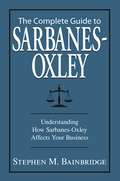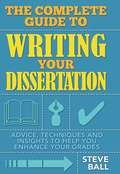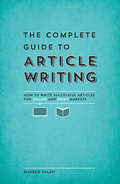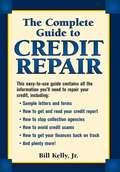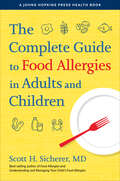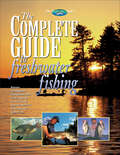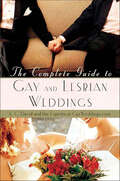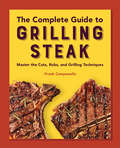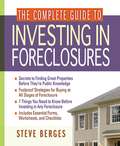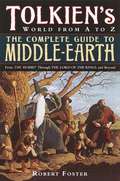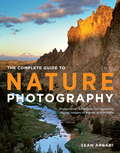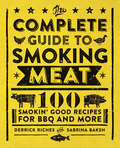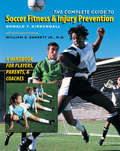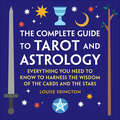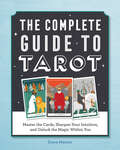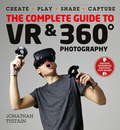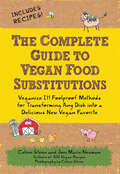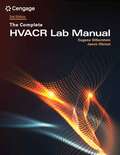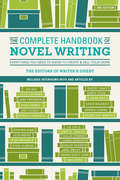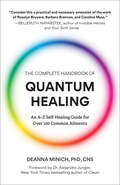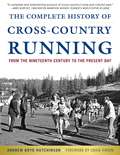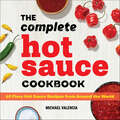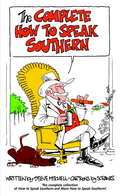- Table View
- List View
The Complete Guide To Sarbanes-Oxley: Understanding How Sarbanes-Oxley Affects Your Business
by Stephen M BainbridgeAs of the end of 2006, small businesses, which were once exempt, now have to comply with Sarbanes-Oxley (SOX). Under Sarbanes-Oxley, they will now be exposed to audits, reviews and will have to make their profits, losses, and compensation packages public.The Complete Guide to Sarbanes-Oxley will answer the following questions:How do companies comply with SOX?How does SOX effect relations within the firm?Should a public company go private to avoid SOX?The Complete Guide to Sarbanes-Oxley is a nontechnical, "plain English" guide for the managers and directors of the 13,000 publicly held corporations now subject to SOX. No business owner should be without it!
The Complete Guide To Writing Your Dissertation: Advice, techniques and insights to help you enhance your grades
by Steve BallIf you are studying at undergraduate or masters level it's likely that you will have to write a dissertation, critical essay or project report before you can graduate. Unfortunately, many good pieces of student research and inquiry are devalued - and sometimes even fail - because they are badly planned, structured or written. Make all that hard work count! This new guide looks directly at the processes, techniques and objectives of writing the dissertation itself. It covers longer term aspects - such as planning, scheduling, structuring - and more immediate ones - such as style, detail and managing the length. - Learn how to understand and decode the academic language of research questions, learning outcomes, objectives and assessment criteria, and translate them into the right form of words. - Discover how to maintain that essential focus on your objectives and research question or hypothesis, and their connection to your discussion and eventual conclusions. - Develop a schedule, identifying the tasks and milestones that will keep you on track, and update the plan as you go. - Find a style and structure that will help shape your writing to satisfy the examiners. - Manage the overall length and chapter lengths, and learn how to cut excess content and avoid repetition. - Master the technicalities of dissertation writing, such as methodologies, literature reviews, note systems, referencing...- Learn to how to transform an adequate dissertation into a good one by attending to fluency and detail - grammar, accuracy, consistency, punctuation - and the controlled use of aids such as spellcheckers and style checkers. - Avoid plagiarism and other evils. How can you avoid falling into cheating, either by accident or by carelessness under pressure? With examples and self-checking exercises to help you to stay on the right track, this essential guide will also serve as a valuable aid to all types of academic writing.
The Complete Guide to Article Writing: How to Write Successful Articles for Online and Print Markets
by Naveed SalehMaster the art of article writing! The world of journalism is changing rapidly, and the modern journalist needs more than a basic knowledge of article writing to navigate it. The Complete Guide to Article Writing provides a compass for freelancers and students of journalism looking to write successfully on a wide variety of topics and for many different markets--both in print and online. From researching and interviewing to writing features, reviews, news articles, opinion pieces, and even blog posts, this one-stop guide will illuminate the intricacies of article writing so you can produce entertaining, informative, and salable articles. Learn how to write coherently, cohesively, and concisely. Choose the proper structure for the article you want to write. Weave narrative and fact seamlessly into your pieces. Develop your freelance platform with the latest in social media outlets. Pitch your ideas like a pro. Develop a professional relationship with editors. And much more! Modern journalism can be a treacherous terrain, but with The Complete Guide to Article Writing as your companion, you'll not only survive the journey--you'll be able to write pieces that inform, entertain, inspire, delight--and sell!
The Complete Guide to Chakras: Activating the 12-Chakra Energy System for Balance and Healing
by April PfenderA complete chakra guide to help you achieve spiritual growth, wellness, and healing If you've ever wondered how each chakra—the foundational energy centers of the body—can help you heal and harmonize your body, mind, and spirit, The Complete Guide to Chakras is the perfect resource. It features detailed profiles that illuminate the innate power of 12 different chakras and how they govern our physical bodies, our emotions, and our potential.The wide range of meditation-based exercises will help you explore how every chakra in your body can be harnessed for strength, vitality, healing, and personal growth. You'll even discover how to use that spiritual knowledge to seek guidance, expand your consciousness, and attract what you desire to live a full and healthy life.This comprehensive chakra guide offers:A complete reference—This book is a comprehensive but accessible introduction to what a chakra is, and how each one can regulate your body's energy system for peace and growth.Discover the 12 chakras—Learn about the Earth Star, the Divine Gateway, and every chakra in between, along with empowering exercises for activating and aligning them for spiritual healing and a deeper connection with yourself.Beyond chakras—Find background information about the long history of the chakras, the endless ways to engage with them, and even some discussion about auras, different dimensions, and more.Understand and align every chakra in your body with this clear and informative guide to inner balance.
The Complete Guide to Credit Repair
by Bill Kelly<p>With more and more people declaring bankruptcy and total debt in this country rising, the time is perfect for a book like <i>The Complete Guide to Credit Repair</i>. Not only will this book show people how to repair bad credit to stay out of bankruptcy, it will show them how to avoid bad credit in the future and what they can do to strengthen their situation. <p>Credit bureau information and other vital resources have all changed within the last few years. <i>The Complete Guide to Credit Repair</i> - written in a simple, straightforward tone - is packed with up-to-date information on a topic that millions of people face everyday.</p>
The Complete Guide to Food Allergies in Adults and Children (A Johns Hopkins Press Health Book)
by Scott H. SichererThe most complete guide to preventing, testing, living with, and treating food allergies in children and adults.In this comprehensive, evidence-based guide for adults and children with food allergies and those who care for them, Dr. Scott H. Sicherer provides all the critical information you need on preventing, testing, living with, and treating food allergies. Organized in an accessible Q&A format and illustrated with case studies, the book thoroughly explains how to prevent exposure to a known allergen at home, at work, at school, in restaurants, and elsewhere. Emphasizing the most recent advances, Sicherer touches on everything from handling an anaphylactic emergency to diagnosing allergies and intolerances, all while detailing chronic health problems caused by food, such as eczema, hives, and gastrointestinal symptoms.He also shares:• the benefits and risks of new therapies• new prevention guidelines• new approaches to improve quality of life and reduce anxiety• the latest insights on adult-onset food allergies• new diagnostic tests now commercially available• approaches shown to increase safety in school• the latest thinking on treating eczema through the diet• new doses and self-injection devices for treating food anaphylaxis• new information about food allergies that affect the gutDr. Sicherer also reviews food reactions that are not allergic, such as lactose intolerance, irritable bowel syndrome, and celiac disease. He explains how to get adequate nutrition when you must avoid dietary staples and discusses whether allergies ever go away (they do—and sometimes they return). Finally, he includes an allergy and anaphylaxis emergency plan and checklists to reduce cross-contamination. This is the most authoritative and accessible allergy book on the market.
The Complete Guide to Freshwater Fishing (The Freshwater Angler)
by Creative Publishing internationalA manual for recreational fishing, with guidance on gear, rigging and information on the most common fish found in North American lakes and streams.The Complete Guide to Freshwater Fishing offers the nearly forty million freshwater anglers in the US with a comprehensive fishing resource. From the highly respected The Freshwater Angler series, this title covers all the major freshwater species in North America. It includes tips and techniques for catching gamefish throughout the country under every conceivable on-the-water situation.In developing this book, the writers, editors and researchers traveled from Alaska to Mexico to fish with veteran guides and nationally known tournament anglers. The tips and techniques they uncovered are fully explained and illustrated in the book.This giant book features:Over 500 spectacular fishing photographs that have never before been published.Extensive step-by-step visuals for learning every important fishing skill, including advanced fishing techniques for many species.The best how-to instruction ever found in any fishing book.Guide-tested tips from some of North America’s top experts.
The Complete Guide to Gay and Lesbian Weddings
by K. C. David"Get out your gay/lesbian rice and celebrate! Taking you from the wedding announcement to the thank you notes, this is the ultimate guide to same-sex ceremonies."-Michael Musto, Village VoiceYour wedding team is here! Let GayWeddings.com help you and your partner plan a ceremony that suits your taste and budget without losing your mind in the process. The absolute authority for same-sex unions on the web, K.C. David and his devoted staff of experts are at your side from the proposal to the honeymoon.- Marriage, civil union, or domestic partnership: protecting your rights and assets together- Finding gay-friendly venues, caterers, and yes, even clergy- Tips for notifying friends and family, and which newspapers run same-sex announcements- Ideas from folks who have already tied the knotPLUS: A wedding timeline checklist, vow writing exercise, sample menus, budget worksheet and more.
The Complete Guide to Grilling Steak Cookbook: Master the Cuts, Rubs, and Grilling Techniques
by Frank CampanellaSet your steak game to sizzleNothing beats a perfectly grilled steak. But how do you create that supremely satisfying flavor at home? Enter The Complete Guide to Grilling Steak. This meaty cookbook is full of tips that take you from purchase and prep through grilling, slicing, and serving a superb steak.What makes this steak cookbook stand out (and makes it a great grilling gift for the pit master in your life):Master the grill—Handle your grill like a pro this grilling season with a primer on gas vs. charcoal, direct vs. indirect heat, achieving the right searing temperature, and so much more.Know your cuts—Learn the difference between a flank steak and a flat iron as you explore the cuts and quality of meat, the aging process, and the best way to prepare every type of steak.Steaks, sides, and sauces—Grill up a full feast with both classic and creative steak recipes, along with perfectly paired sides, rubs, and marinades.Pick up this must-have grilling cookbook and serve some spectacular steaks this summer!
The Complete Guide to Investing in Foreclosures
by Steve BergesThe Complete Guide to Investing in Foreclosures is written to help you identify and take advantage of opportunities while avoiding the pitfalls.As demand for real estate has skyrocketed, so have prices. But finding affordable properties to buy and sell for profit has never been easier! Why? Because foreclosures are at an all-time high, meaning banks and other lenders have unprecedented numbers of properties they are all too eager to unload. That's your opportunity to acquire prime properties -- both residential and commercial -- at incredible value, and build a substantial real estate portfolio that should give you great returns for years to come.Real estate investment professional Steve Berges gives you:Secrets for finding great properties before they're public knowledgeFoolproof strategies for buying properties at all stages of foreclosureImportant information you need to know before investing in any foreclosurePowerful ways to take advantage of little-known alternatives like HUD, SBA, VA, and IRS properties, Fannie Mae and Freddie Mac foreclosures, pre- and post-foreclosure opportunities, and moreA full selection of value assessment tools, lead-generation strategies, and practical step-by-step processesThe 7 Caveats of Investing in ForeclosuresForeclosures may be the quickest and most reliable way to profit in real estate-but you've got to know what you're doing. Whether you're new to the game or are already experienced in buying and selling foreclosed properties, The Complete Guide to Investing in Foreclosures gives you everything you need to make smart moves at every stage of the process.
The Complete Guide to Middle-Earth: From The Hobbit Through the Lord of the Rings and Beyond
by Robert Hill FosterFor the millions who have already ventured to Middle-earth, and for the countless others who have yet to embark on the journey–here is the one indispensable A-to-Z guide that brings Tolkien’s universe to life. EVERY CHARACTERFrom Adaldrida Brandybuck to Zaragamba–every Hobbit, Elf, Dwarf, Man, Orc, or other resident of Middle-earth is vividly described and accurately located in proper place and time. EVERY PLACEColorfully detailed descriptions of geographical entries allow you to pick up the action anywhere in Middle-earth and follow it through all five volumes. EVERY THINGFrom stars and streams to food and flora, everything found in Middle-earth is alphabetically listed and, when necessary, cross-referenced. HERE IS TRULY A MASTER KEY TO TOLKIEN’S MIDDLE-EARTH
The Complete Guide to Modern Massage: Step-by-Step Massage Basics and Techniques from Around the World
by Ryan Jay Hoyme LMT, BCTMBLearn the healing power of touch with a new, up-to-date reference from The Complete Guide to Modern Massage. Massage is a natural method to relieve pain and reduce stress—and anyone can learn how to do it. The Complete Guide to Modern Massage offers an updated reference to learn popular techniques and feel the physical and emotional benefits of massage. From classic styles such as Swedish or Shiatsu to new favorites like Ayurvedic and Thai, this massage guide offers illustrated, step-by-step instruction to master techniques from around the world. Complete with massage practices for pain relief, you'll learn how to heal your family, friends, partners, and even yourself of common ailments with your own two hands. The Complete Guide to Modern Massage includes: An introduction to massage that outlines the history and basic principles of massage and how they relate to modern practice. World-famous massage techniques that include Deep Tissue, Reflexology, Tui Na, Cranialsacral, Reiki, and more! Restorative applications for healing common ailments including headaches, neck pain, PMS, lower back pain, and more. Easy-to-follow guidance with illustrations, and simple step-by-step directions to master every technique. Give and receive rejuvenating massages with world-famous techniques and step-by-step instructions from The Complete Guide to Modern Massage.
The Complete Guide to Nature Photography: Professional Techniques for Capturing Digital Images of Nature and Wildlife
by Sean ArbabiThe authoritative guide for photographing nature in today's digital world Infused with both a passion for nature and an abundance of technical expertise, The Complete Guide to Nature Photography guides amateur photographers through every stage of shooting landscapes, close-ups, and animal portraits in today's digital world. Master nature photographer Sean Arbabi offers insider advice on everything from packing your gear bag to selecting sites, staying safe while working in the field, getting a perfect exposure, composing your images for maximum impact, and processing your digital images afterward. Packed with more than 200 inspiring and instructive images, this complete course is the only book you'll need to capture the beauty of the world around you.From the Trade Paperback edition.
The Complete Guide to Smoking Meat: 100 Smokin' Good Recipes for BBQ and More
by Derrick Riches Sabrina BakshLearn everything you need to know to make mind-blowingly delicious smoked meats There's something about the intoxicating aroma of brisket roasting over an open flame. Makes your mouth water, doesn't it? The Complete Guide to Smoking Meat gives you the know-how to make melt-in-your mouth smoked meat at home. This essential smoker cookbook provides clear, step-by-step methods and recipes that will get you fired up about BBQ and turn you into a meat smoking master. What sets this BBQ cookbook apart from other smoker recipes cookbooks: Smoker fundamentals—Learn all about smokers, the basic tools you'll need, how to set up cooking zones, and more. Master your fire—Discover which wood to use to achieve the flavor you desire, how to prep meats, and strategies for achieving the perfect amount of smoke. 100 smokin' good recipes—Make everything from traditional low and slow BBQ to hot and fast meat dishes, including Central Texas Barbecue Brisket, Spicy Smoky Dino Ribs, and Peruvian Chicken with Aji Verde. You also get smoked sides and fruit- and vegetable-based recipes to add to your wood-fired repertoire. Cook up the best BBQ in town with The Complete Guide to Smoking Meat.
The Complete Guide to Soccer Fitness and Injury Prevention
by Donald T. KirkendallWhat are the best fuel foods for soccer players? What training regimen will best prepare young soccer players and improve their resistance to injuries? This comprehensive guide to health and fitness for soccer players offers expert advice for soccer teams at all levels. With decades of combined experience treating and training elite soccer players, exercise physiologist Donald Kirkendall and orthopedic specialist William E. Garrett Jr. present complex issues in an easy-to-understand format. The book addresses the physical and mental demands of the game, including the differences between boys' and girls' games and the differences in the levels of play in youth, college, and professional leagues; nutrition fundamentals, including food, drink, and vitamin supplements; physiology and training methods, with an emphasis on the basic elements of flexibility, speed, strength, and conditioning; and injury treatment and prevention.For players looking to step up their game, for parents who want to keep their kids healthy, and for coaches seeking the advice of the pros, this guide is an indispensable reference to keep handy on the sidelines.This comprehensive guide to health and fitness for soccer players offers expert advice for soccer teams at all levels. With decades of combined experience treating and training elite soccer players, Donald Kirkendall and William E. Garrett Jr. present complex issues in an easy-to-understand format. They discuss training practices, physical problems soccer players often encounter, and ways to treat and prevent injury. For players looking to step up their game, for parents who want to keep their kids healthy, and for coaches seeking the advice of the pros, this guide is an indispensable reference to keep handy on the sidelines.Topics covered include:* Important differences between boys' and girls' games* Best foods and fluids for maximum performance* Basic training concepts* Speed training tips* Training considerations specific to female athletes* Muscle soreness* Treatment of head, knee, leg, ankle, foot, and other injuries* When to return to play after an injury-->
The Complete Guide to Tarot and Astrology: Everything You Need to Know to Harness the Wisdom of the Cards and the Stars
by Louise EdingtonIlluminate your purpose and your path through tarot and astrology Tarot and astrology can be effective tools when you need to work through complicated feelings and questions. This comprehensive guide examines how useful the two practices can be when combined, highlighting the insight they offer into relationships, personal decisions, and so much more.What sets this tarot book guide apart:Foundations of tarot and astrology—A complete overview explores the evolution of both tarot and astrology, including essential elements like planets, suits, houses, and modalities.Sample readings and spreads—Build a relationship with your cards and hone your ability to interpret their symbols with examples of classic readings and spreads, including the Horseshoe and Full Moon.Card profiles—Take a deeper dive into the Major Arcana cards, like The Magician, as well as Minor Arcana cards, like the Queen of Swords, and discover how they represent life events and archetypal issues.Harness the power of tarot and astrology for personal growth and self-discovery with this comprehensive guide.
The Complete Guide to Tarot: Master the Cards, Sharpen Your Intuition, and Unlock the Magic Within You
by Dawn MarinoFind answers in the cards with this comprehensive reference Manifest with the Magician, pave the way for new beginnings with the Tower, and connect to your subconscious with the High Priestess. Tarot will empower your intuition and help you gain insight into your life and the lives of others. This comprehensive tarot book guide demystifies the ancient art to provide you with the knowledge and techniques you need to approach your tarot practice with confidence. You'll unlock your destiny by learning tarot symbols and meanings, how to set intentions, and how to create and read spreads for any situation. Tarot fundamentals—Begin your journey with tarot history, tips for connecting with your tarot cards, and advice on focusing your intentions. Bring your cards to life—Dive into your deck with profiles of all 78 cards that include upright and reversed keywords, prominent symbols, and astrology, as well as a glossary of key terms for easy reference. Tarot spreads—Learn card spreads for personal growth, overcoming obstacles, and peering into the past, present, and future. Tap into your wisdom and open up a whole new world of possibilities with this tarot card meaning book.
The Complete Guide to VR & 360 Photography: Make, Enjoy, and Share & Play Virtual Reality
by Jonathan TustainThe Complete Guide to VR will help you get to grips with this exciting new technology from first principles, so you know what's out there, and what you want.Discover all there is to know about home VR systems, whether they're computer-based, or work using your mobile phone. This book will introduce you to a whole spectrum of VR possibilities including VR games, creating your own VR films and exploring the world using it.
The Complete Guide to Vegan Food Substitutions: Veganize It! Foolproof Methods for Transforming Any Dish into a Delicious New Vegan Favorite
by Celine Steen Joni Marie Newman“It reveals exactly how to replace any ingredient in any recipe. The results aren’t just stellar—they’re even better than the ‘real’ thing!” —Rory Freedman, #1 New York Times–bestselling author of Skinny BitchThe Complete Guide to Vegan Food Substitutions is your secret weapon to turning any recipe imaginable into a deliciously “veganized” success—no guesswork or hard labor involved. And no more kitchen failures or recipe flops either. Simply look up whatever non-vegan ingredient you want to sub out, and expert author team Celine Steen and Joni Marie Newman will explain exactly what substitution is best to use and how to make it without compromising taste or flavor, so you’ll create dishes that are not only better than the “real” thing, but healthier, too.With more than 200 recipes and substitutions that show the swaps in action, you’ll find step-by-step instructions for replacing everything from butter and bacon to gelatin and gouda. You’ll also find healthy substitutions for replacing things like gluten, sugar, and fat, so you can fine-tune any recipe to your dietary needs. You and your family and friends will be amazed and delighted with these and more plant-based dishes:Eggs Benedict with HamWestern Bacon CheeseburgersIndian-Spiced Pumpkin GratinCheesy “Chicken” CasseroleFish-y Sticks with Tartar SauceWalnut Chocolate BrowniesVanilla Latte Ice CreamStunning photography and easy-to-follow charts appear in every chapter, making it a cinch to dip in and out whenever you need a quick reference or recipe. If you’ve always wanted to turn your aunt’s famous mac and cheese into a veganized taste sensation, or your grandma’s buttermilk pie into a rousing, “reinvented” success, this guide is the solution you’ve been looking for!
The Complete HVACR Lab Manual
by Eugene Silberstein Jason ObrzutThe Complete HVACR Lab Manual is a comprehensive resource that covers the essential knowledge and skills required to be an HVAC technician. Featuring over 250 lab exercises, this lab manual is designed to support the hands-on application and practice needed to confidently approach HVAC/R system issues.
The Complete Handbook of Novel Writing: Everything You Need to Know to Create & Sell Your Work
by Writer's Digest EditorsGet advice from the best in the business on every stage of the novel-writing and publishing process! In The Complete Handbook of Novel Writing, 3rd Edition, you'll learn from established writers about how to make your novel a reality. Discover techniques and strategies for generating ideas, connecting with readers emotionally, and finding inspiration you need to finish your work. This fully revised edition includes an updated marketing section for navigating the unique challenges and possibilities of the evolving literary marketplace. Inside you'll find new essays from dozens of best-selling authors and publishing professionals detailing how to:Master the elements of fiction, from plot and character to dialogue and point of viewDevelop a unique voice and sensibility in your writingManage the practical aspects of writing, from overcoming writer's block to revising your workDetermine the key elements for success in every genreFind an agent, market your work, and get published--or self-publish--successfullyYou'll also find interviews with some of the world's finest and most popular writers, including David Baldacci, Lee Child, Robert Crais, Khaled Hosseini, Hugh Howey, Stephen King, Dennis Lehane, George R.R. Martin, Jojo Moyes, Anne Rice, Jane Smiley, and Garth Stein. Their insights on the craft and business of fiction will provide you with invaluable mentorship as you embark on your writing journey.The Complete Handbook of Novel Writing is your go-to guide for every aspect of creating a bestseller.
The Complete Handbook of Quantum Healing: An A–Z Self-Healing Guide for Over 100 Common Ailments
by Deanna MinichThe holistic healing handbook for a homeopathic household. &“This book is a beautiful integration of Eastern and Western healing disciplines.&” —Scott Rigden, MD, author of The Ultimate Metabolism Diet Heal your body naturally using an array of well-researched and long-practiced techniques. This easy-to-understand holistic healing library provides multiple healing approaches to the most common ailments, so you&’ll have access to the best approach for you and will be feeling better in no time. Our lives are intertwined with the unexpected. We are bound to become ill or get hurt, probably multiple times in our lives. When that happens, The Complete Handbook of Quantum Healing makes healing your body easy by providing an A-Z reference guide of over 100 health issues, each with healing options using different types of holistic medicine, so you&’ll be sure to find the best approach—or approaches—for you. See real results through trusted techniques. A perfect holistic healing gift or addition to anyone&’s natural health kit, The Complete Handbook of Quantum Healing seamlessly blends new-world science with old-world knowledge. With her deep understanding of both the medical and the spiritual side of healing, author Deanna Minich, PhD, translates her medical knowledge to simple holistic healing techniques that anyone can use and that have been shown to work. Inside, you&’ll find: An A-Z list of over 100 common ailments Seven self-healing options for each ailment including herbal medicines, essential oils, crystals, and more Self-healing quotes, meditations, and healing energy exercises to restore the body and the soul If you like natural healing books such as The Modern Herbal Dispensary, Medical Medium, or When the Body Says No, you&’ll love The Complete Book of Quantum Healing.
The Complete History of Cross-Country Running: From the Nineteenth Century to the Present Day
by Hutchinson Andrew Boyd Virgin CraigIn The Complete History of Cross-Country Running, author Andrew Boyd Hutchinson captures the full history of cross-country running, from the early 1800s to the present day, on both a national and international scale. It includes chronicles of legendary teams, inspirational tales of achievement, controversies, and interviews with record-breaking runners past and present. From Walter George and Alfred Shrubb to Steve Prefontaine, Bill Rogers, and Galen Rupp—and everyone in between—Hutchinson uncovers all angles, via training logs, discussions with coaches, and the review of newspaper archives for race results and forgotten storylines. He offers commentary from Olympians such as David Torrence and Shannon Rowbury, amongst others. Along the way, the book addresses the following topics: • How cross country began in England • How the sport found its way to American colleges and universities • The birth of the International Cross-Country Championships • All the close events, including the 2012 race between Molly Huddle and Sara Hall at the US National Cross-Country Championship • And so much more!
The Complete Hot Sauce Cookbook: 60 Fiery Hot Sauce Recipes from Around the World
by Michael ValenciaSpice up mealtime with 60 easy-to-make hot sauce recipesHot sauces can add zesty characteristics to just about any meal. From interesting new flavors and bright colors to fiery sensations, they can turn an ordinary dish into an extraordinary one. The Complete Hot Sauce Cookbook gives you a deep and comprehensive look into the wonderful world of hot sauce. Discover how to rate a pepper's hotness with the Scoville Scale, the various types of peppers, and other flavoring options to toss in. With recipes ranging from Central America to Southeast Asia, this comprehensive hot sauce cookbook is sure to elevate your cooking.The Complete Hot Sauce Cookbook includes:Array of flavors—This hot sauce cookbook offers plenty of options for hot sauces that range in spiciness.What's new?—Get updated information on the ever-changing pepper landscape.Keep it fresh—Learn about the best ways to preserve your sauces.Add heat and flavor to your meals with The Complete Hot Sauce Cookbook.
The Complete How to Speak Southern
by Steve Mitchell Sam C. RawlsThe laugh sensation that swept the nation, How to Speak Southern and More How to Speak Southern, is now collected in one complete-and completely hilarious-volume. Embraced by Southerners everywhere and dedicated to all Yankees in the hope that it will teach them to talk right, this uproarious book decodes "Suthun" wit and wisdom for "Nawthun" upstarts everywhere. From "aig" (a breakfast food that may be fried, scrambled, boiled, or poached) to "zackly" (as in "precisely"), here's just a sampling of what you'll find inside: ATTAIR: Contraction used to indicate the specific item desired. "Pass me attair gravy, please."EVERWHICHAWAYS: To be scattered in all directions. "You should have been there when the train hit that chicken truck. Them chickens flew ever which aways."YONTNY: Do you want any. "Yontny more corn bread?" Funny as well as informative, this laugh-out-loud dictionary will keep you laughing and learning-no matter where you fall on the Mason-Dixon Line! From the Hardcover edition.
